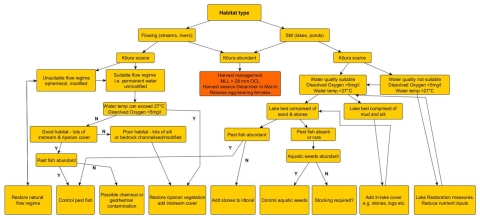Step 2: Why are kōura rare or absent in your waterway?
Several abiotic (habitat) and biotic (biological) factors can affect the abundance of kōura populations in New Zealand these include: water flow, water temperature, water quality, habitat structure (cover), and predation. One or more of these three factors may affect your waterway and reduce kōura numbers. This kōura decision support system (DSS) can help identify the main causes of low kōura abundance in New Zealand waterways.

Habitat limitations
Adult and juvenile kōura have varying habitat requirements. If a habitat requirement is not present, kōura that rely on it will not be abundant in your waterway.
Are habitat requirements missing?
For more information on different land uses and point source discharges can cause a variety of environmental impacts on water quality and mahinga kai see What impacts interest you?
Water flow
Physical habitat features such as rapids, riffles and pools, as well as water depth and velocity, are determined by the interaction between the rate of flow and stream. If there is insufficient flow it may be natural or due to water abstraction or land use changes upstream. Check whether the flow is sufficient for kōura habitats.
Water quality
If suitable physical habitat and cover are both present and recruitment is not a problem, the absence of kōura may be due to poor water quality. Summer water temperatures may be too high (>27oC) for or dissolved oxygen levels may be too low (< 5 mg/l). Nutrients in waterways are essential for the growth of algae and aquatic plants but too much can degrade an ecosystem. See more information on nutrient overloading and eutrophication.
Detection of chemical spills and chemical contamination that can kill or displace most kōura is difficult—most chemicals are unlikely to still be present. Regional councils may be able to assist in reducing chemical spills and kōura recolonisation will occur naturally after these events provided that there are source populations of colonists elsewhere in the catchment of your focus waterway.
Cover
Cover is an essential habitat requirement for kōura with the abundance of kōura positively correlated with the abundance of refuges. In lakes, cobbles provide important shelter for kōura and reduce effects of predators on juvenile kōura (see Kusabs et al. 2015a). Whereas, in streams, woody debris, stones (of all sizes) and tree roots all provide cover for kōura. Kōura are generally less abundant in areas with soft or muddy substrates, which might be due to increased sediment runoff.
Riparian cover is also important for kōura in streams and the loss of riparian vegetation can adversely affect kōura populations. Juvenile kōura are particularly prone to being washed away during floods and the presence of tree roots provides valuable protection for juveniles and adults. Trees also provide leaf litter that is an important source of food for kōura. If cover is lacking, kōura may be absent or scarce, even though physical habitat is otherwise suitable. It is important to identify ways of creating natural cover or adding artificial cover to streams.
Land and water use changes
Changes in land and water use in the catchment area can affect stream geomorphology by changing the rates of water flow. Faster flows caused by a lack of forested catchment will increase runoff (more flash floods) and siltation. Smaller flows from water abstraction (removal) reduce water velocities and kōura habitat. Dams may also change substrate structure and channel shape.
Some habitats may be lacking due to natural geomorphological features (e.g., the presence of bedrock); artificial changes in stream morphology (e.g., channelisation, deepening and straightening) can also reduce kōura habitat. If loss of physical habitat has occurred because of artificial changes in the stream channel, identify which habitats are lacking to determine what type of restoration is required.
See more information about how modified habitats can affect kōura abundance.
Biological limitations
Kōura may still be scarce or absent even though habitat is present and there is no recent history of pollution or floods.
Are biological limitations present?
Identifying biological factors that may be limiting kōura numbers requires sampling to ensure that invertebrate prey species are not scarce and that pest fish, especially predators, are not abundant.
Predatory fish
Pest fish can reduce the abundance of kōura through competition, predation and aggressive behaviour. If introduced predators such as trout, catfish, perch are present, kōura are likely to be scarce. A range of pest control methods are available to help reduce the impact of pest species on kōura, for more information see controlling pest fish. It should be noted that kōura may not be abundant if eel numbers are high, due to natural predation pressure.
Overfishing
Kōura may be scarce if they have been overfished particularly in small streams. Detection of overfishing requires a comparison of the abundance and size of kōura with a reference site (i.e. a similar reach where fishing pressure is light). Fishery management may be required to restrict harvest or to control pest species. (see Kusabs et al. 2015b.)
Food supply
Kōura are omnivores consuming invertebrates, plants and detritus therefore food is not usually a limiting factor. However, if invertebrate food supply is limited (for instance, because of heavy siltation), kōura abundance will decline. High densities of large insect larvae such as mayflies and caddisflies are an indication of good food supply for kōura.
If invertebrate food is scarce, then the factors limiting food need to be identified and remedied before kōura can be fully restored. Flushing flows below dams can be used to simulate a flood and restore substrate for invertebrates. Better management of siltation via riparian planting upstream may also be required.
Disease
Overseas, disease and parasite infections can result in a sudden and dramatic decline in the abundance of freshwater crayfish. However, these have not been reported for kōura in New Zealand to date, so they are unlikely to account for a reduction in kōura abundance.
